Cons
-
Abysmal black levels
It's a nice TV, but shallow black levels torpedo the QN85A given the high price.
The QN85A offers most of the same features as Samsung's high-end QN90A, including HDMI 2.1, a 120Hz refresh rate, Samsung’s Tizen smart platform, as well as gaming-related features like Variable Refresh Rate and Auto Low Latency Mode. The “guts” of the QN85A are similar to the QN90A, too; both TVs pair quantum dots with Samsung’s mini-LED backlights.
But while the QN90A blends searingly bright highlights with respectable black levels, the QN85A’s black levels look a bit washed out—especially for a TV in this price range—lacking the contrast of its competitors. Without the impressive contrast to hang your hat on, Samsung’s usual pain points—like a lack of Dolby Vision support—hit harder than they do on a TV like the QN90A.
Editor’s note: While we have fully tested the QN85A in our labs, due to COVID-19 considerations, this review leans more heavily on lab data and less on time spent watching content.
About the Samsung QN85A
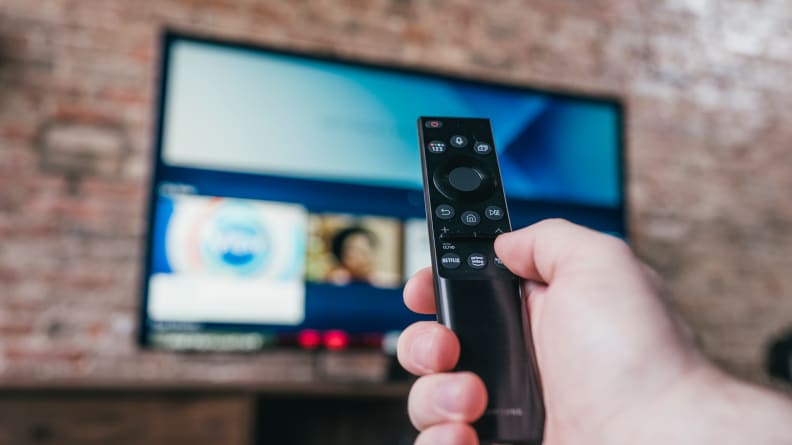
Credit: Reviewed / Jackson Ruckar
The Samsung QN85A is available in four sizes: 55 inches, 65 inches, 75 inches, and 85 inches.
The Samsung QN85A isn't the company's flagships, but it's one of its highest-end TVs of 2021. Though not quite as kitted out as the top-tier Samsung QN90A, it is the most affordable way to secure one of Samsung’s Neo QLED TVs. This hardware suite combines quantum dot technology with mini-LED backlights.
The QN85A is available in four sizes: 55 inches, 65 inches, 75 inches, and 85 inches. The review unit we’re covering is a 55-inch model that we purchased ourselves. Here’s how all of the sizes stack up from a price standpoint:
- 55-inch (Samsung QN55QN85AAFXZA), MSRP $1,599.99
- 65-inch (Samsung QN65QN85AAFXZA), MSRP $2,199.99
- 75-inch (Samsung QN75QN85AAFXZA), MSRP $2,999.99
- 85-inch (Samsung QN85QN85AAFXZA), MSRP $4,449.99
Typically, we expect a TV series’ performance to remain consistent from one size to the next (unless there are major hardware differences between the size variants). However, we have reason to believe that the Samsung QN85A hardware may vary depending on panel size, especially the massive 85-inch version. We’ve reached out to Samsung for clarification and we’ll update this review with more information once we hear back.
Here are some key specs shared by every size in the QN85A series:
- Resolution: 4K (3,840 x 2,160)
- Display type: Neo QLED (quantum dots + mini-LED)
- HDR support: HDR10, HDR10+, HLG
- Dolby Atmos: Yes (passthrough)
- eARC support: Yes
- Native refresh rate: 120 Hz
- Smart platform: Yes (Tizen Smart TV)
- Color: DCI-P3/10-bit color space
- Processor: Neo Quantum Processor 4K
- Variable Refresh Rate (VRR): Yes (FreeSync)
- Auto Low Latency Mode (ALLM): Yes
- Other features: Object Tracking Sound+, Motion Xcelerator Turbo+, Q-Symphony, SpaceFit Sound, Active Voice Amplifier, Super UltraWide GameView, GameBar, Multi View, Tap View, Samsung TV Plus, Universal View, Samsung Health
Although the QN85A and the QN90A both make use of Samsung’s Neo QLED display technology, our lab tests indicate that the QN85A is most likely an IPS-style panel (as opposed to the QN90A’s VA-style panel). I’ll explain why the distinction matters further on in this review, but we're still trying to shake out exactly which sizes have which panel type.
Like most Samsung TVs in 2021, the QN85A comes loaded with Samsung's Tizen-based smart platform. It's not our favorite streaming platform (that honor goes to Roku), but it's fine in a pinch. Either way, we highly recommend you opt for an external streaming device that you can upgrade and replace as formats and technology improve.
Performance data
Before testing each TV, we make sure the panel is on and receiving a continuous signal for at least 24 hours, allowing the pixels plenty of time to warm up. Our 55-inch QN85A received this standard warm-up time before any readings were taken.
For both SDR and HDR tests, we used Samsung’s “Movie” picture setting. We’ve chosen this picture mode because of its accuracy, but results may vary depending on which picture mode is enabled.
To get a sense for the TV’s average performance, we use a standard ANSI checkerboard pattern for most of our basic contrast tests. We also use white and black windows ranging from 2% to 90% to test how well the contrast holds up while displaying varying degrees of brightness.
Our peak brightness measurements are taken with sustained windows, so these figures represent the TV’s peak brightness over a sustained period of time. Specular highlights (like brief flashes of reflected light) might reach higher brightness levels in dynamic content, but not for a sustained period of time.
All of our tests are created with a QuantumData 780A signal generator and tabulated via Calman Ultimate. I'll expand on our test results throughout the review, but for now, here are some key takeaways:
• HDR contrast (brightness/black level): 729.1 nits/0.446 nits (ANSI checkerboard)
• SDR contrast (brightness/black level): 296.8 nits/0.025 nits (ANSI checkerboard)
• HDR peak brightness (sustained): 1,157 nits (50% white window)
• HDR color gamut coverage (DCI-P3/10-bit): 95.7%
• SDR color gamut coverage (rec.709): 99.8%
Connectivity
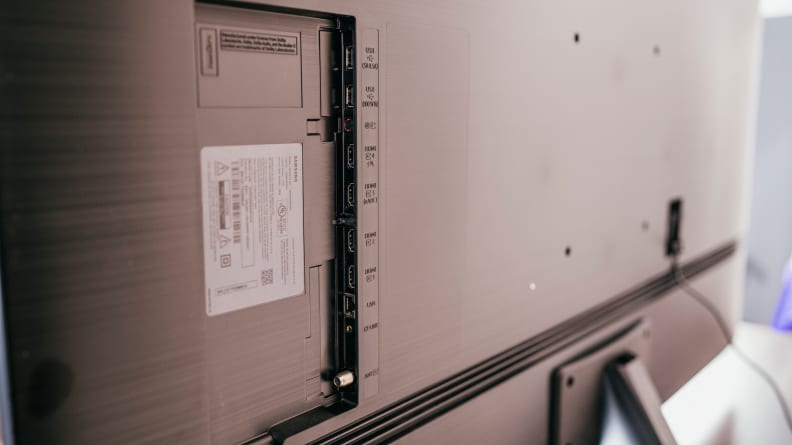
Credit: Reviewed / Jackson Ruckar
Only one of the QN85A's four HDMI ports supports HDMI 2.1-specified features.
The Samsung QN85A provides an above-average selection of connectivity options, but A/V enthusiasts ought to note that only one of the TV’s HDMI ports supports HDMI 2.1 features. That may be less of an issue now, but as more HDMI 2.1 devices come available, you may find the single port frustrating.
Here’s what you’ll find in a cutout on the back of the QN85A’s panel:
• 4x HDMI (3x HDMI 2.0b, 1x HDMI 2.1, 1x eARC)
• 2x USB 2.0
• Composite input
• LAN ethernet port, RF input, optical (digital) audio output
In addition to its single HDMI 2.1-specified port, the QN85A also features eARC support on one of its four HDMI ports.
What We Like
Excellent brightness and respectable color
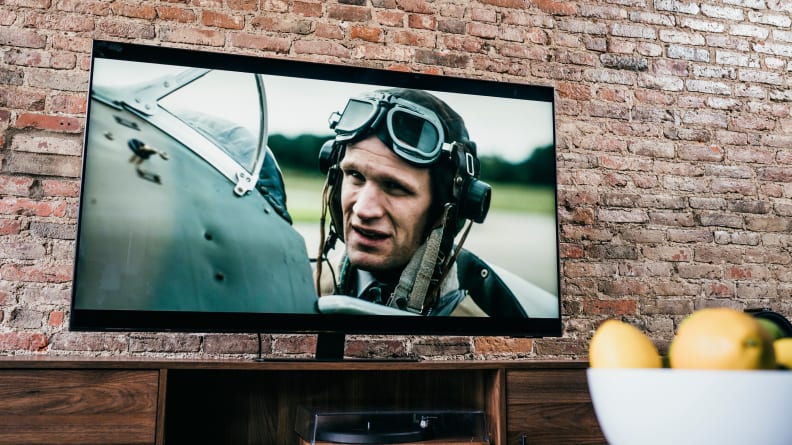
Credit: Reviewed / Jackson Ruckar
The QN85A is capable of sustained brightness levels of around 900 to 1,000 nits, with specular highlights sometimes exceeding those levels.
In recent years, high-end Samsung TVs have earned a reputation for being some of the brightest TVs money can buy, thanks in part to Samsung’s embrace of quantum dots and some seriously clever engineering. And while the Samsung QN85A doesn’t quite reach the brightness levels of Samsung’s top-shelf flagship, the QN90A, it still packs a heck of a punch, particularly during HDR content. We measured sustained brightness levels of around 900 to 1,100 nits in HDR (in the TV’s “Movie” picture mode) and you can expect even brighter, unsustained highlights in HDR, depending on the content.
The QN85A is a “Neo QLED” TV, which means that it marries Samsung’s quantum dot technology with the company’s newest iteration of its mini-LED backlighting hardware. Mini-LEDs are much smaller than previous versions of LED backlights that power traditional full-array TVs, so manufacturers can cram far more LEDs into a display than ever before. The QN85A likely features less of these mini-LEDs than the QN90A, but their inclusion nevertheless helps the QN85A focus its energy on the areas of the picture that need it. There is some moderate light bloom to contend with (more on that later), but for the most part, the QN85A controls contrasting picture elements quite well.
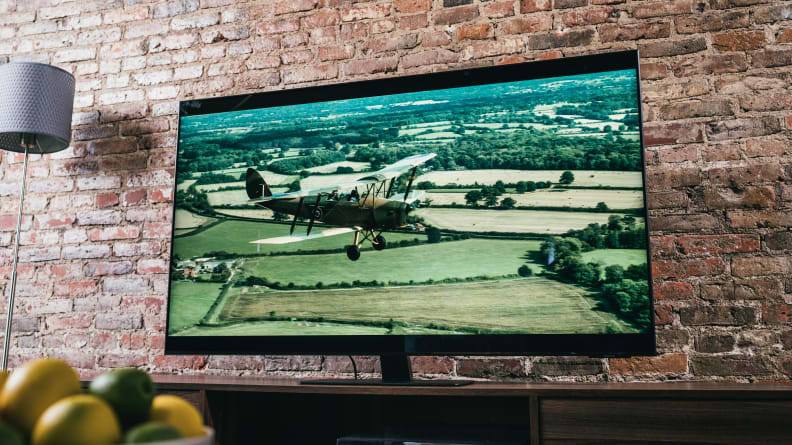
Credit: Reviewed / Jackson Ruckar
Being a quantum dot TV, the QN85A also showcases colors exceptionally. Its boosted brightness allows for supremely saturated reds, greens, and blues, and regardless of the type of content, you can expect accurate, rich color reproduction. Covering about 96% of the DCI-P3 (HDR) color gamut, it’s not the best we’ve seen this year, but most folks will love what they see. That said, true color chasers would be remiss to not investigate the Samsung QN90A, whose added brightness makes colors pop even further.
A great option for gaming
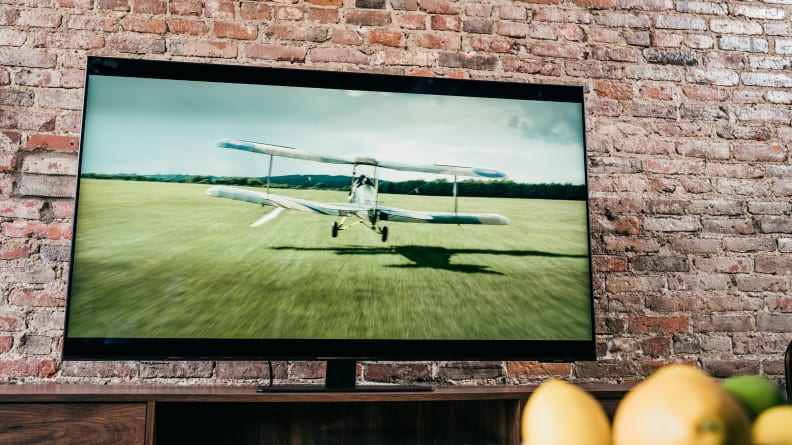
Credit: Reviewed / Jackson Ruckar
The QN85A's native 120Hz refresh rate and its suite of motion enhancements deliver top-shelf motion handling.
If you own (or you’re planning on owning) a PlayStation 5 or Xbox Series X, you'll want a TV that supports all of its next-gen features completely. The QN85A provides such support, and while it’s not strapped with all the possible bells and whistles, it’s a fine choice for gamers looking for a taste of the future.
Leading the charge is the TV’s HDMI 2.1 port, which offers expanded bandwidth (combined with the TV’s 120Hz native refresh rate) allowing for 4K/120fps gaming. The QN85A also supports FreeSync, AMD’s version of Variable Refresh Rate (which prevents screen tearing and artifacting during gameplay) and Auto Low Latency Mode, which, when enabled, automatically initiates Game Mode when the QN85A detects a gaming signal.
It’s important to remember that only one of the QN85A’s HDMI ports is equipped with these capabilities, so if you’re hoping to hook up more than one device that takes advantage of HDMI 2.1-specified features, the QN85A might be a tough pill to swallow. It’s nice, however, to have these options in tow, even in a limited capacity.
Only one of the QN85A’s HDMI ports is equipped with HDMI 2.1-related capabilities.
Game aficionados will also be happy to learn that the QN85A’s motion handling is excellent, and its suite of motion-related software enhancements is among the most robust out there. It might take you some time to find the settings that you enjoy the most; there’s LED Clear Motion (an optional black frame insertion feature that minimizes motion blur), as well as Judder and Blur Reduction sliders.
New this year to select Samsung TVs—including the QN85A—is Game Bar, a menu that lives at the bottom of the screen and offers users quick access to gaming-related information and optional features. You can check to see if HDR is enabled, monitor a game’s frames-per-second output, and change the aspect ratio on the fly. It’s a small touch but one that I’m sure both serious and casual gamers will appreciate.
Jam-packed with features
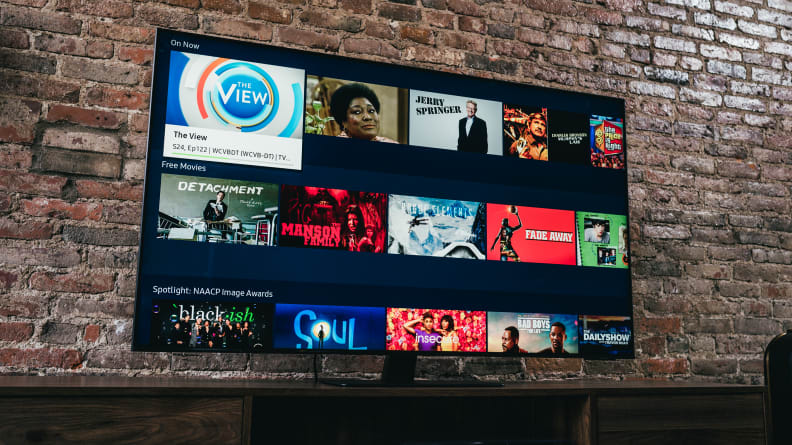
Credit: Reviewed / Jackson Ruckar
In addition to a host of extra features and enhancements, the QN85A also offers Samsung's Tizen smart platform, which is faster now than in years past.
While gamers get the lion’s share of the QN85A’s bounty of bonus features, the TV offers a host of extras that will satisfy folks who want a bit more bang for their buck—whether you own a soundbar or not.
In the audio department, the QN85A comes equipped with Samsung’s new SpaceFit Sound functionality, which analyzes the contours of a room and adjusts the TV’s audio accordingly. There’s also something called Active Voice Amplifier, which responds to ambient noise by boosting the volume of on-screen dialogue.
If you own a new Samsung soundbar with Q-Symphony compatibility, the QN85A is ready to make the most of it; being one of Samsung’s Neo QLED TV, the QN85A supports the feature, which incorporates the TV’s speakers into the soundscape.
The QN85A is ready to make the most of your new soundbar.
Lastly (and most importantly), the QN85A supports eARC and is able to pass Dolby Atmos audio to a soundbar or other supported devices.
Non-audio-related extras include Multi View (which gives users the ability to watch more than one source at a time), Tap View (a feature that mirrors your Samsung Galaxy smartphone display when you tap it on the TV), and a suite of Samsung Health features that work alongside other Samsung Health-enabled devices.
What We Don’t Like
Dreadful black levels and irksome light bloom
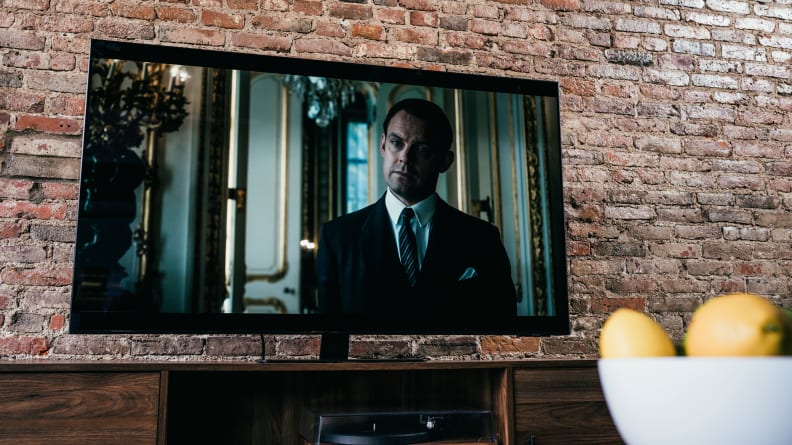
Credit: Reviewed / Jackson Ruckar
The QN85A's black levels—particularly in HDR—are so shallow that they crush details. This is most noticeable in dark scenes.
For a TV of this caliber, we were surprised to observe shallow black levels on the QN85A, particularly while receiving an HDR signal. While using a standard ANSI checkerboard pattern in HDR, we measured black levels of around 0.350 to 0.450 nits, which is quite high, even for a standard LCD TV with LED backlights. To put this into perspective, the QN90A’s black level while displaying this pattern clocked in at a much lower 0.059 nits—it’s not even close.
While receiving an SDR signal, the QN85A is able to dip a little deeper into black and make use of its local dimming algorithms, but it’s still nowhere near the depths we expect to see on a TV this expensive. In practice, this means far less shadow detail than there ought to be in darker scenes—something we confirmed while watching Blu-rays in the lab.
We were surprised to observe shallow black levels.
Our assumption is that the QN85A is using an IPS-style panel rather than a VA panel. While VA-style panels offer terrific contrast and so-so viewing angles, IPS panels are known for less-than-stellar contrast and above-average viewing angles. We’ve reached out to Samsung to confirm whether or not the QN85A is using an IPS panel and whether any other sizes in the series use this panel technology, too. We’ll update this review as soon as we hear back.
For the most part, the QN85A does exhibit tight contrast control, no doubt the result of the TV’s abundance of mini-LEDs. And to be fair, the QN85A gets bright enough to mitigate the effects of these shallow black levels—especially in bright rooms where your eyes aren't as sensitive. Still, we did notice a fair amount of light bloom around brighter picture elements when surrounded by darkness. This effect is even more prominent when viewing the QN85A from off-center angles. And while we also observed this phenomenon while reviewing the Samsung QN90A, the issue was more apparent on the QN85A—likely a result of a lower mini-LED count.
No Dolby Vision support
Like all Samsung TVs, the QN85A does not support Dolby Vision support, and in its place offers support for HDR10+, a comparable alternative that lacks the licensing fees associated with Dolby Vision. While HDR10+ has its advantages, the QN85A is not certified for true Dolby Vision support, which means Dolby Vision-mastered games, movies, and TV shows won’t be showcasing the true nature of the format.
To be clear, HDR content will look great on the QN85A—the TV gets plenty bright to deliver the goods. That said, it’s something to keep in mind as major studios and streaming platforms like Disney+, Amazon Prime, and others continue to adopt the Dolby Vision format. If staying on the cutting edge is important to you, you might be better off shopping for a Dolby Vision TV.
Somewhat uninspired design
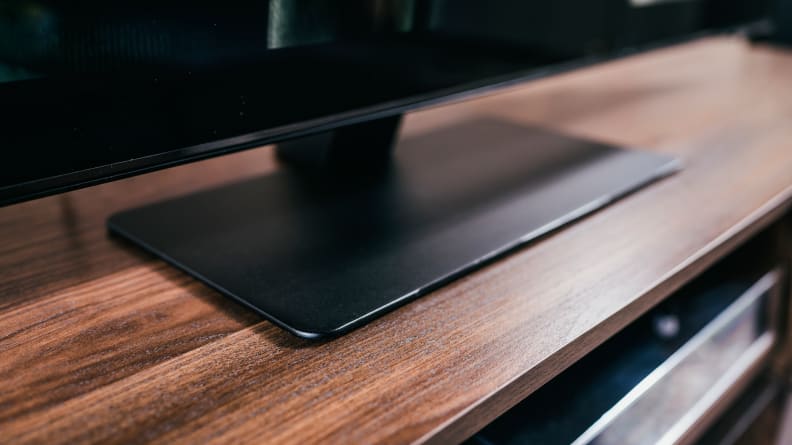
Credit: Reviewed / Jackson Ruckar
The QN85A's stand design won't turn any heads, and at times, it causes the panel to wobble.
The best thing about the QN85A’s physical design is how thin its panel is—not nearly as thin as an OLED, but thinner than most of the backlit LCD/LED TVs we’ve been testing this year.
Unfortunately, the TV’s stand—a flat, rectangular plate that connects to the back of the QN85A’s panel—looks a little drab, especially compared to the upscale stand design of the QN90A. We also noticed a fair amount of wobble while moving the TV and plugging in devices due to the width of the panel and the manner in which it connects to the stand.
Should You Buy It?
Yes, but only if you can live with the flaws—and wait for a price drop
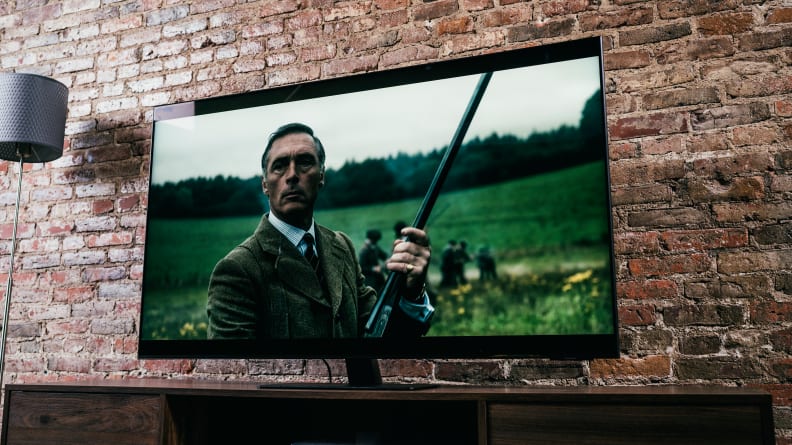
Credit: Reviewed / Jackson Ruckar
The QN85A shares most of the QN90A's features, but can't compete with the QN90A's performance, which offers much better contrast.
When we reviewed the Samsung QN90A, we were impressed with its ability to combine excellent brightness with very good black levels. We hoped the QN85A would be similar, with a handful of minor concessions (like fewer HDMI 2.1 ports and a slightly lower performance level). Unfortunately, our lab results tell a different story: this is a wholly different TV with, we suspect, different hardware.
Its features are comparable to the QN90A—and when it comes to brightness and color, it does nip at the QN90A’s heels—but the QN85A’s remarkably high black levels keep it from competing on the same level. We do expect the $1,599 starting price to drop a bit as time goes on, but for the current asking price you may as well go all-in on the QN90A and get the real thing.
If you don’t have your heart set on a Samsung-branded TV, you could explore other high-end options like the LG G1. If you’re after the blazing brightness of a QLED TV, however, your best bet is to shop for a 2020 Samsung Q90T (which offers similar gaming-related features as the QN85A) or to simply fork over the cash for the higher-end QN90A.
The Samsung QN85A is still a very good TV. It is bright, colorful, and has plenty of next-gen features. It has all the trappings of a second-tier luxury TV, but its shallow black levels are holding it back.
Meet the tester
Michael Desjardin graduated from Emerson College after having studied media production and screenwriting. He specializes in tech for Reviewed, but also loves film criticism, weird ambient music, cooking, and food in general.
Checking our work.
We use standardized and scientific testing methods to scrutinize every product and provide you with objectively accurate results. If you’ve found different results in your own research, email us and we’ll compare notes. If it looks substantial, we’ll gladly re-test a product to try and reproduce these results. After all, peer reviews are a critical part of any scientific process.
Shoot us an emailApril 03, 2021 at 08:20AM
https://ift.tt/3cM2GxI
Samsung QN85A Neo QLED TV Review: a perplexing package - Reviewed
https://ift.tt/31VSHRH
Samsung

No comments:
Post a Comment